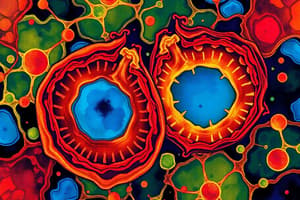Podcast
Questions and Answers
What is the main difference between mitosis and meiosis?
What is the main difference between mitosis and meiosis?
- Mitosis forms genetically diverse cells, while meiosis forms identical cells.
- Mitosis results in two identical nuclei, while meiosis results in four genetically unique cells. (correct)
- Mitosis occurs in reproductive cells, while meiosis occurs in somatic cells.
- Mitosis leads to the formation of four nuclei, while meiosis results in two nuclei.
Which type of tissue is responsible for movement and is found in muscles?
Which type of tissue is responsible for movement and is found in muscles?
- Connective Tissue
- Muscular Tissue (correct)
- Epithelial Tissue
- Nervous Tissue
What is the function of the cell membrane?
What is the function of the cell membrane?
- It covers the surface of the body and lines internal organs.
- It controls the movement of substances in and out of the cell. (correct)
- It carries signals between different parts of the body.
- It provides support to the cell.
Why is cell division essential for the growth of an organism and repair of damaged tissues?
Why is cell division essential for the growth of an organism and repair of damaged tissues?
What is the function of the cytoplasm in a cell?
What is the function of the cytoplasm in a cell?
Which tissue in plants transports sugars and other nutrients from the leaves to other parts of the plant?
Which tissue in plants transports sugars and other nutrients from the leaves to other parts of the plant?
What is the main function of cells in the body?
What is the main function of cells in the body?
Which part of the cell is described as the control center of the cell and contains most of the cell's genetic material?
Which part of the cell is described as the control center of the cell and contains most of the cell's genetic material?
Flashcards
Mitosis
Mitosis
Cell division resulting in two identical nuclei.
Meiosis
Meiosis
Cell division resulting in four genetically unique cells, occurring in reproductive cells.
Epithelial Tissue
Epithelial Tissue
Covers body surfaces and lines internal organs.
Connective Tissue
Connective Tissue
Signup and view all the flashcards
Muscular Tissue
Muscular Tissue
Signup and view all the flashcards
Nervous Tissue
Nervous Tissue
Signup and view all the flashcards
Cell Membrane
Cell Membrane
Signup and view all the flashcards
Xylem
Xylem
Signup and view all the flashcards
Study Notes
Biology Class 9 Chapter 5: Cell Division, Tissues, Cell Structure, and Cell Functions
Cell Division
Cell division is the process by which the cell grows and renews itself, creating a new cell for the body to use in different parts. It is essential for the growth of an organism and the repair of damaged tissues. There are two main types of cell division:
-
Mitosis: This is the process by which the nucleus of a cell divides, leading to the formation of two identical nuclei.
-
Meiosis: This is a type of cell division that occurs in the reproductive cells of an organism, resulting in the formation of four genetically unique cells.
Tissues
Tissues are groups of cells that work together to perform specific functions. There are four main types of tissues:
-
Epithelial Tissue: This type of tissue covers the surface of the body and lines the internal organs.
-
Connective Tissue: This tissue connects different parts of the body and provides support.
-
Muscular Tissue: This tissue is responsible for movement and is found in muscles.
-
Nervous Tissue: This tissue carries signals between different parts of the body and is found in the brain and nerves.
Cell Structure
The structure of a cell is divided into three main parts:
-
Cell Membrane: This is a thin layer that surrounds the cell and controls the movement of substances in and out of the cell.
-
Cytoplasm: This is the jelly-like substance inside the cell membrane that contains all the organelles.
-
Nucleus: This is the control center of the cell and contains most of the cell's genetic material.
Cell Functions
Cells have various functions in the body, including:
-
Metabolism: Cells convert food into energy and other necessary substances.
-
Growth and Reproduction: Cells grow and divide to create new cells for the body.
-
Repair: Cells can repair damaged tissues and organs.
-
Excretion: Cells help in the removal of waste products from the body.
Plant and Animal Tissues
Plants and animals have different types of tissues, with plants having additional tissues such as:
-
Xylem: This tissue transports water and minerals from the roots to the leaves.
-
Phloem: This tissue transports sugars and other nutrients from the leaves to other parts of the plant.
-
Collenchyma: This tissue provides support and is found in the walls of some cells in the plant.
In summary, cell division is an essential process for the growth and repair of the body. Tissues are groups of cells that work together to perform specific functions. Cell structure is divided into three main parts: cell membrane, cytoplasm, and nucleus. Cells have various functions in the body, and plants and animals have different types of tissues to perform their specific functions.
Studying That Suits You
Use AI to generate personalized quizzes and flashcards to suit your learning preferences.




